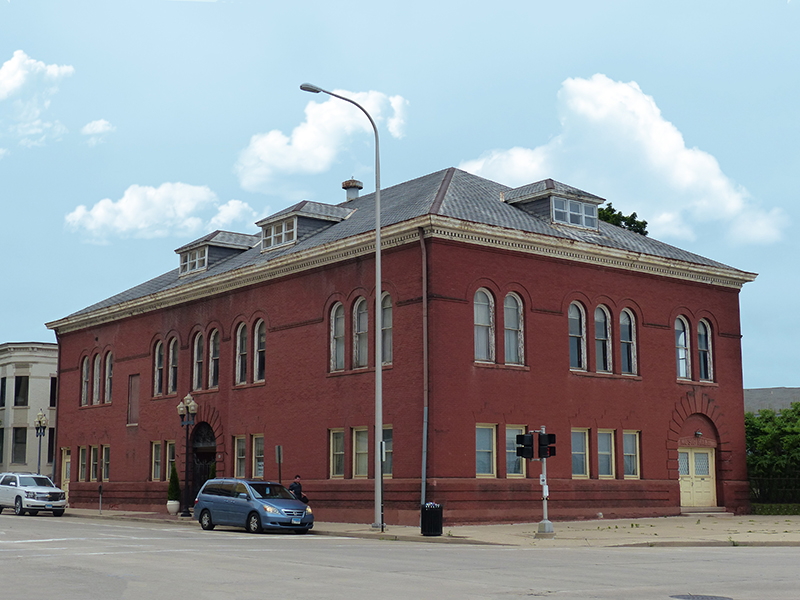A Historic Restoration

What an exciting time in the 132-year history of the Peoria Women’s Club! Philanthropist Kim Blickenstaff, a native son of our region, has generously committed $500,000 to assist in the restoration of our beautiful building and its 432-seat theatre. The KDB Group, chaired by Blickenstaff, has also provided a structural analysis to prepare for planning and budgeting.
These gifts are providential. With membership increasing and a desire to host performances once again in the theatre, we invite our greater community to become engaged and support our historic club.
An Enduring Landmark
Located at the corner of Fayette and Madison in downtown Peoria, the Peoria Women’s Club (PWC) building was designed by the Chicago firm of Jenney & Mundie. Known as the “Father of the American Skyscraper,” William LeBaron Jenney, a noted architect and engineer of the day, also designed the world’s first skyscraper—the Home Insurance Building, erected in 1884 in the Chicago Loop.
The building’s cornerstone was laid in 1893. While PWC originally planned for a modest structure, the need for a concert and lecture hall in Peoria was so apparent that additional debt was assumed to construct this magnificent clubhouse—reminiscent of what could be seen in any European capital. The handsome, Romanesque Revival-style building of solid red brick and sandstone is characterized by semi-circular Roman arches over the entry and second-floor windows. And unlike similar buildings in Peoria, it has never been altered.
True to its original design, the interior remains intact, right down to the authentic gas light fixtures, hat racks and numbered seats with their original wood finishes. Entering the concert hall today is a remarkable feeling—like stepping back into a well-preserved time capsule where Lydia Moss Bradley or Clara Parsons Bourland would feel right at home… aside from the peeling paint!
The Music Hall is considered to be acoustically perfect. It once hosted the Peoria Symphony Orchestra and renowned guests like Victor Hugo, Carl Sandburg, Ethel Barrymore and Julia Ward Howe. The theatre took in patrons and guests to listen to Shakespeare and Chopin, as well as lectures on topics as diverse as nutrition, public affairs, weaving and Russian history.
This enduring landmark still stands, unchanged more than 125 years after its construction. It is a testament to the club’s foresight, dedication to excellence, and its efforts to educate, spread culture and encourage philanthropy.

Pioneering Community Leadership
The Peoria Women’s Club was chartered in 1886 and incorporated in 1890, prior to the building’s construction. It is not only the oldest standing club in Peoria; it was the second women’s club in the entire nation. Clara Parsons Bourland was the galvanizing force behind its formation and served as the club’s first president for 25 years, inspiring others with her own values of education and culture. Under her leadership, the PWC influenced every aspect of the Peoria community—civic, intellectual, artistic, philanthropic and social—and helped elevate the status of women long before that was a popular idea.
The club has persevered through two world wars, Prohibition and the Great Depression—as well as the perilously close construction of Interstate 74. During the terrible years of World War I, its members unselfishly donated time and money to the efforts of the Red Cross. Amidst the sweeping influenza pandemic of 1918, they gave over the use of their building to the City of Peoria as a hospital. The dramatic transformation of those elegant rooms—ideal for high tea and enlightened conversation—was to be the smallest price paid, as numerous members lost their own lives during this heroic endeavor.
PWC also played a critical role in lobbying Springfield for more humane treatment of the mentally ill, resulting in the construction of the State Hospital in Bartonville in 1898. Other examples of its social conscience include working to improve child labor laws, placing a woman on the local school board, starting kindergarten in the public schools, and establishing a traveling library to surrounding towns where such amenities were not available. (And, lest anyone question the ladies’ steely resolve beneath their gracious etiquette and flair for fashion, they also helped pass legislation to stop men from spitting in streetcars and on the sidewalks!)
The Peoria Women’s Club has been empowering women to lead and serve in the Peoria area since 1886. We encourage you to come tour our facility! We hope you will fall in love with our rich history and join us to preserve this remarkable building, as we continue the tradition of our founding members through education, cultural development and philanthropic service. PM
Marjorie A. Schwebel is president of the Peoria Women’s Club, located at 301 NE Madison Ave. in Peoria. Visit peoriawomensclub.com to learn more or to donate to the restoration project.
- Log in to post comments

